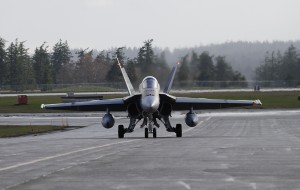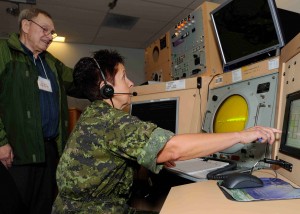
A CF-18 was the last aircraft to be guided to a safe landing at 19 Wing Comox using the Precision Approach Radar before its decommissioning on June 28, 2013.
Photo by: Sgt Robert Bottrill, 19 Wing Imaging
Military Air Traffic Control personnel gathered for a ceremony to de-commission the PAR system after 32 years in service at Comox. PAR enabled a controller to follow the course of an aircraft with sufficient precision to guide it by verbal instructions to less than half a mile from touchdown so that a pilot could make a visual landing safely.
“The Precision Approach Radar equipment at Comox, first entered service in 1953-54 and was further upgraded as part of the Navigational Aids fleet in 1979,” said Major Dan Ceniccola, 19 Wing Air Traffic Control Officer. “The PAR provided the RCAF with the capability to land aircraft in low visibility with voice only instructions from a controller- often the approach aid of choice during emergency situations.”
The controllers using the PAR system at 19 Wing were critical to maintaining aviation safety at Comox. In January 1999, Master Corporal John Healey, a PAR Controller, was recognized by the Air Force for his professionalism in guiding a lost Cessna 210 to the safety of 19 Wing Comox, when the pilot, flying between Peace River Alberta and Campbell River suffered mechanical problems and became disoriented in the mountains sixty miles northeast of Comox.
The pilot radioed a mayday, while his engine sputtered and ice built on the wings. Terminal Air Traffic Controllers directed him toward Comox, but the pilot was unable to see the runway through the heavy clouds and fog, forcing him to overshoot and try again. With fuel running dangerously low, MCpl Healey got on the radio and, using the PAR system, gave clear and concise instructions to the pilot to guide him in for a safe landing. This represents only one of several stories of the dedicated PAR Controllers who saved lives during the system’s operational history at 19 Wing.

Retired Air Traffic Control Officer, Captain Peter Morin, watches Master Corporal Heather Moss, an Air Traffic Controller at 19 Wing Comox, use the Precision Approach Radar for the last time to guide a CF-18 pilot to a landing before the system was decommissioned on June 28, 2013.
Image by Cpl Jennifer Chiasson
©2013-DND-MDN CANADA
PAR is being replaced with the Aerodrome Precision Approach Landing System at three RCAF Wings in Canada (3 Wing Bagotville, 8 Wing Trenton and 19 Wing Comox). APALS is an autonomous precision approach and landing system designed to enable low visibility landings by using ground based radio signals to display the runway centreline and approach path on instruments in the aircraft cockpit.
“During the course of PAR’s history at Comox, thousands of practice Precision Radar Approaches have been conducted on this Wing,” said Colonel Jim Benninger, 19 Wing Commander. “While new systems coming in are more advanced, it still takes the professionalism and vigilance of Air Traffic Controllers and aeronautical safety standards to ensure safe landings.”
“Precision Radar Controllers have a special bond with the aircraft they control, particularly in poor weather conditions when the pilot is relying on their precise control instructions to get them down safely,” said MCpl Heather Moss 19 Wing Air Traffic Control. “As PAR Controllers, we always loved telling pilots where to go!”


